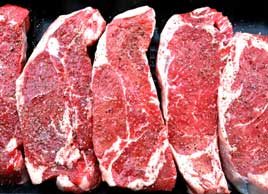Ask Best Health: Is red meat bad for my health?
Confused about whether you should eat red meat? Here are the pros and cons, plus tips on proper portion sizes

Source: Web exclusive, September 2011
It’s hard to go anywhere and not face the temptation of red meat, a category that includes meats that are dark before cooking such as beef, pork, lamb and goat, as well as game meats such as duck, bison and venison. Thanks to plenty of bad press, many of us may feel guilty about eating it more than once a week, even if we’re not exactly sure why. According to Nicole Fetterly, a registered dietitian in Vancouver, B.C., we eat far more red meat than we should. “We should limit red meat to 2.5 ounces [about 70 grams], once or twice a week,” she says. Most public health authorities, such as the Canadian Cancer Society, recommend up to three servings per week.
Is red meat good for us?
All meat, including poultry, provides important nutrients like iron, vitamin B and protein. But all meats, especially red meat, contain saturated fats, the type that raise our blood cholesterol levels, leading to plaque build-up in arteries and increased risk of heart disease. “The trouble is we’ve switched to a grain-fed farming system [from a grass-fed one] and that’s increased the levels of saturated fat in red meat,” says Fetterly. “By feeding cows corn and other grains to fatten them up, all we are doing is fattening ourselves up.”
The dangers of red meat
‘ Colorectal cancer
On the one hand, red meat is high in iron, the kind that is easily absorbed by the body (unlike plant sources of iron), says Fetterly. However, she notes, “excess amounts of iron could potentially damage the intestinal tract, leading to diseases such as cancer.” Studies have shown that a diet high in red meat increases the risk of colon cancer. New preliminary evidence also links it with other cancers including liver and prostate cancer.
‘ Heart disease
Several major studies have shown that people who eat red meat virtually every day have much higher risks of death from heart disease than those who eat the smallest amounts.
How can we indulge safely?
‘ A cut above
Treat yourself to only the leanest cuts and look for round, loin, inside or outside round roast, eye of round steak, strip loin or sirloin steak. According to the Heart and Stroke Foundation of Canada, tenderloin cuts of meat can be lean if visible fat is removed. “Make your red meat count,” adds Fetterly. “Opt for fine quality cuts rather than lean ground beef, which is more easily substituted with ground turkey or chicken. Most people say they can’t afford fine cuts, but if you reduce your intake to once a week, you’ve made up the difference.”
‘ Serve up moderation
One serving (2.5 ounces/70 grams) is about the size of a small deck of cards. Consider upping your vegetable content or add some meat-free sources of protein such lentils and eggs to your meal.
‘ Do the prep
Trim red meat of excess visible fat before cooking to reduce the fat content. Don’t cook your meat in added fat and watch the salt. Instead, try flavouring the meat with marinades using olive oil, garlic, lemon juice and herbs. Marinades are also excellent ways to reduce exposure to a dangerous cancer-causing byproduct of cooking meats at high temperatures called heterocyclic amines (HCA).
Don’t miss out! Sign up for our free weekly newsletters and get nutritious recipes, healthy weight-loss tips, easy ways to stay in shape and all the health news you need, delivered straight to your inbox.




